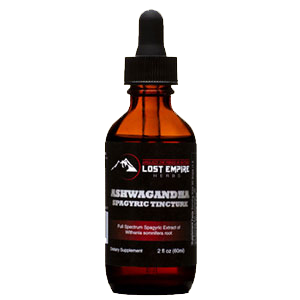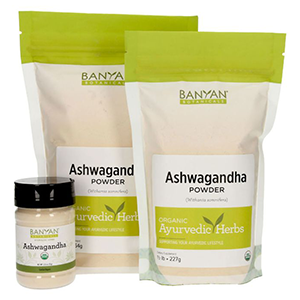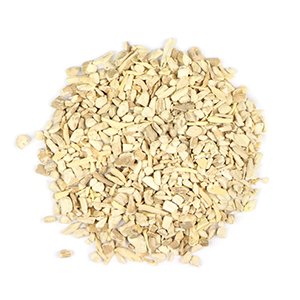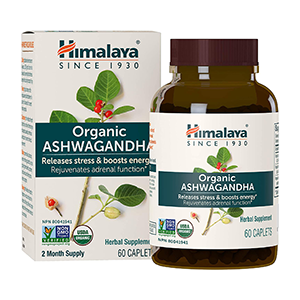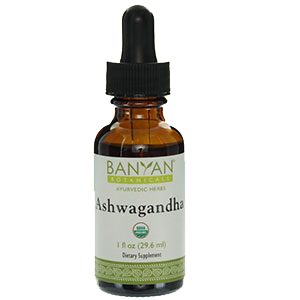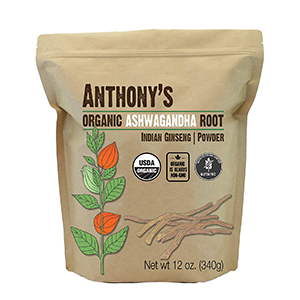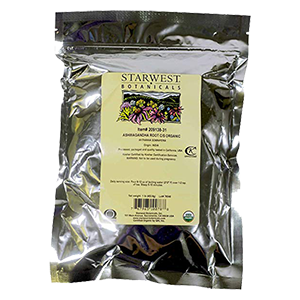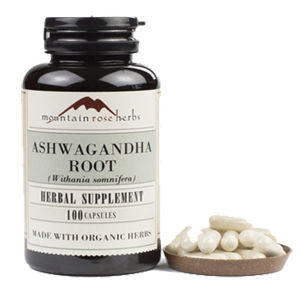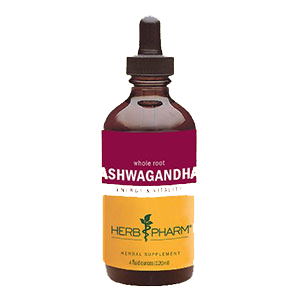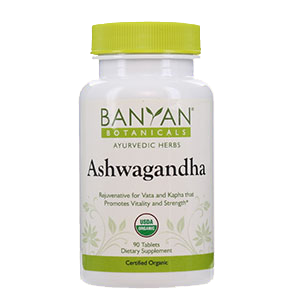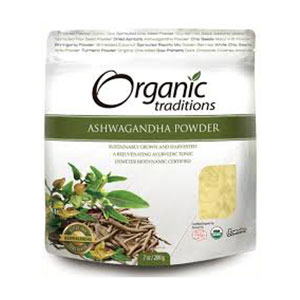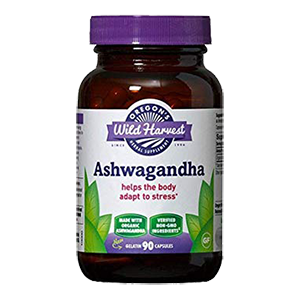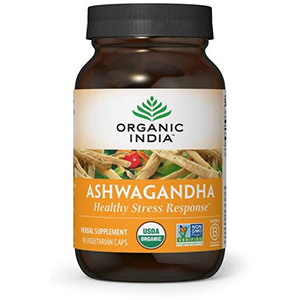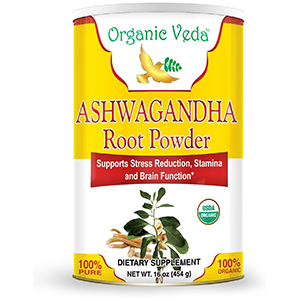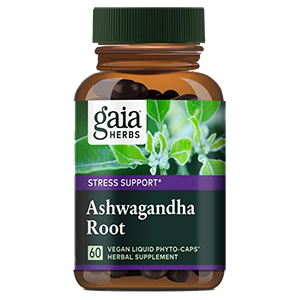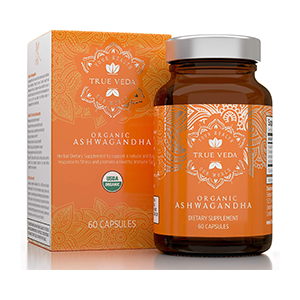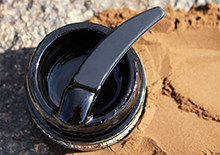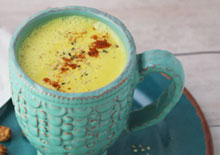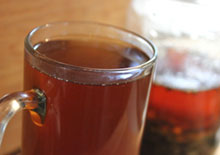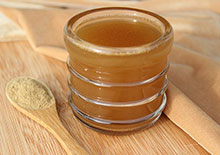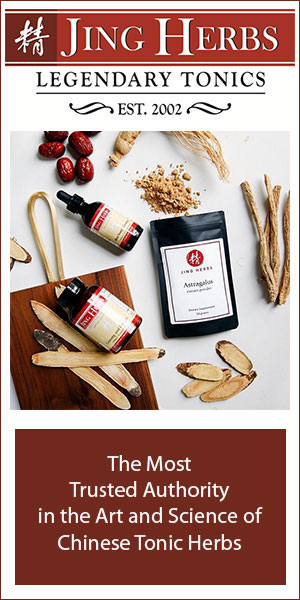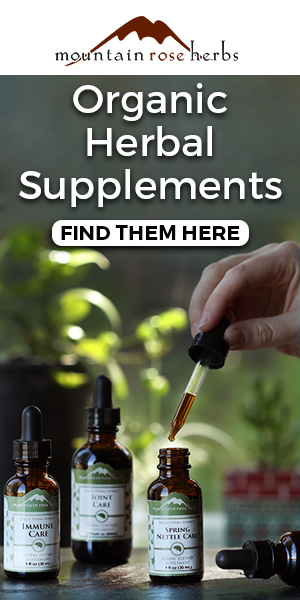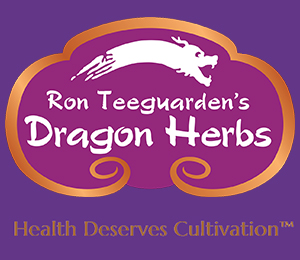- Home
- Ayurvedic Herbs
- Benefits of Ashwagandha
Health Benefits of Ashwagandha, Top Ayurvedic Rasayana
Intro | When to Take Rasayanas | What is Ashwagandha? | Grow Your Own | Health Benefits | Withanolides | Types | How to Use | Precautions | Shop
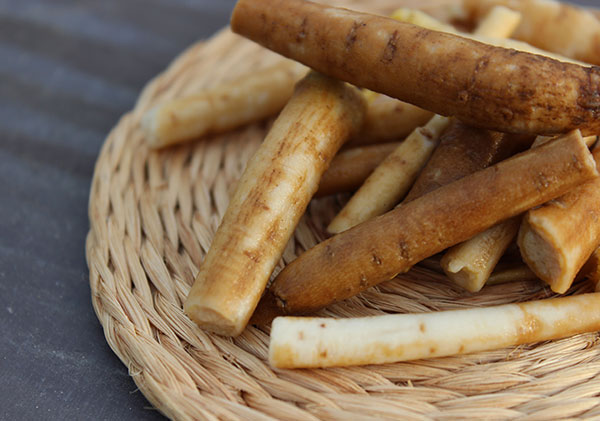
Ashwagandha root is one of the top most highly valued tonic herbs commonly utilized in Ayurvedic herbalism. Known as "Indian ginseng" for its energizing, strength building and restorative impact, it helps to relieve physical fatigue and is particularly famous for its revitalizing effects on the male reproductive system.
Traditionally consumed with other Ayurvedic herbs in herbal formulations geared to specific constitutions or body types, ashwagandha is found in many blends for addressing adrenal exhaustion, insomnia, hormonal imbalance, anxiety and debilitating weakness.
Table of Contents
Intro | When to Take Rasayanas | What is Ashwagandha? | Grow Your Own | Health Benefits | Withanolides | Types | How to Use | Precautions | Shop
While the leaves of the plant have respected therapeutic value, the root of the ashwagandha shrub is the most common part used for herbal supplementation. Typically, the long slender roots are harvested when mature after a full growing cycle and sometimes sold as a whole dried root or in pieces. It is, however, more universally available as a bulk powder, encapsulated powder or compressed tablet.
In Chinese medical terms, it is considered both a renewing kidney Yang tonic and Chi (Qi) activator. Although, it is often seen as a male libido enhancer, it is generally fortifying for the reproductive system in both men and women alike.
According to herbalist Dr. Michael Tierra, author of Planetary Herbology, "It is easily the most potent tonic aphrodisiacs in the entire botanical kingdom."
Recognized as an ancient Ayurvedic "rasayana" herb used for thousands of years in the traditional Indian herbal system, it can be a rejuvenating yet calming nerve tonic and a frequent ingredient utilized in many energy building preparations to promote vigor, vitality and, according to Ayurvedic scriptures, increase one's lifespan.
Rasayana herbs, like ashwagandha, are believed to nourish the whole body by strengthening the primordial tissue. Rasayana literally means "the path that rasa takes" (rasa: the primordial tissue and plasma; ayana: the path).
Functioning as an adaptogen, ashwagandha root and its herbal actions are double directional, offering different effects depending on what is most needed by any one individual. In other words, it can be stimulating like Panax ginseng or calming like American ginseng. Generally, it known to ground, center and enliven ones natural energy especially when used for an extended period of time.
Root powders and extracts have been examined for their ability to
heighten resilience to stress and improve the body's defense against
disease through active antioxidant and anti-inflammatory compounds such
as the specific phytochemicals referred to as withanolides.
Scientifically studied for decades regarding this range of unique plant substances, withanolides, like withaferin A, have been shown to provide immune modulating and neuroprotective support.
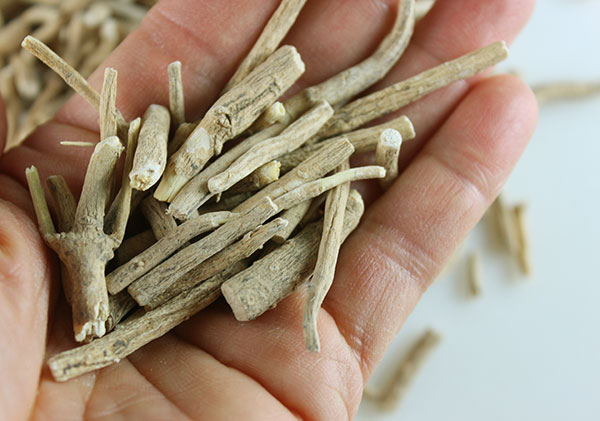
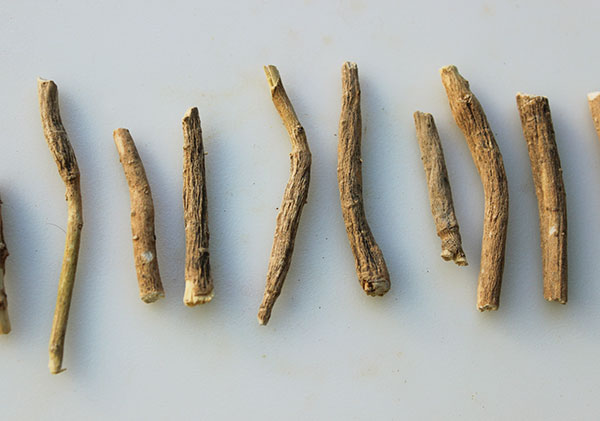
Consumed as a tea, powder, tablet or as a tinctured extract, the root of ashwagandha is a nourishing herb suitable for a wide range of people from children to seniors. (*)
Ashwagandha is particularly good for correcting Vata imbalance and is a top renowned tonic for the elderly due to its potential usefulness as a pain reliever, anti-inflammatory and respected influence as a nourishing herb for nervous debility.
Understanding your body type, or "dosha", is paramount in Ayurvedic medicine and is important for tailoring a dosha-balancing diet with a list of foods and Ayurvedic herbs, like ashwagandha, that are specific for your unique constitution and acute or chronic issues.
In the Ayurvedic system of medicine, this can be a preventative approach to health as it helps you to avoid sickness and disease before it takes form. Often times it is additionally beneficial to seek the advice of a qualified Ayurvedic practitioner, who can further evaluate your individual needs and the herbs best suited for your distinct situation and health concerns.
When to Take Rasayana Herbs
It is generally recommended in Ayurveda to undergo "rasayana therapy" (using rasayana herbs) after a detox or cleansing regimen. This is a time when the systems of the body are more receptive and "open to" the assimilation of rasayana herbal supplementation.
In the words of Dr. Harsharnjit Puri, "It has been stressed that Rasayana administered without these treatments is like seed sown on barren land, from where no good results can be expected."
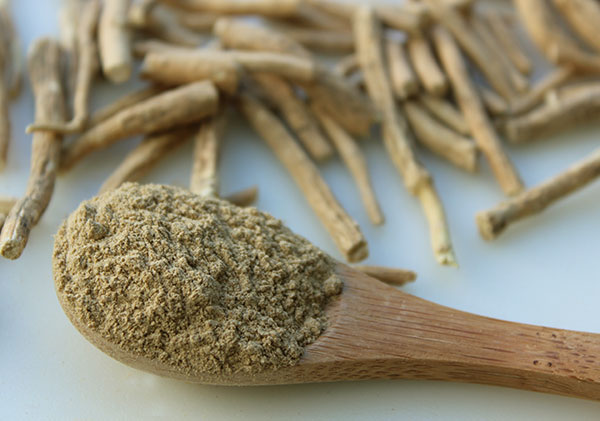
What is Ashwagandha?
Ashwagandha root (Withania somnifera) comes from the class of nightshades or family Solanaceae. It has been used as a popular herb in India and neighboring countries for literally thousands of years. Mentioned in classic herbal Ayurvedic texts, like the Charaka Samhita and the Bhavaprakasha, it was used extensively and incorporated into traditional preparations for a number of health issues.
Also known as winter cherry or poison gooseberry, the ashwagandha plant is a low growing perennial shrub, usually reaching heights of between 14–30 inches (35–75 cm) tall. Similar to the golden berry plant (Physalis peruviana), Withania somnifera produces flowers that eventually develop fruits within a papery thin skin or calyx.
Unlike golden berries, however, the red-orange fruits are not usually consumed as a food source. The seeds within the berry are used as a replacement to rennet in cheese making and the berry pulp can be used as a poultice along with the leaves directly on the skin.
Ashwagandha is widely cultivated and most notably grown for its long slender roots that are typically harvested after the first year's growth cycle. The cultivated plant is believed to have originated in Rajasthan, India where it was known as asgandh nagori.
The taste of the root is bitter, astringent and sweet. Mixed with water, clarified butter, honey or milk, it is most commonly used as a fine powder, created by grinding the unprepared dried roots.
Withania somnifera is known to produce certain alkaloid substances, such as ashwaganidhine, ashwagandhine and somniferine, that are uniquely found exclusively within this particular plant species.
Grow Your Own Ashwagandha Plant
We always promote growing your own superfoods and herbs whenever possible. Many species grow exceptionally well in permaculture settings with other types of edible foods and herbs.
Although ashwagandha is native to drier regions of India, it has also adapted to many tropical, subtropical and temperate climate zones around the world. As a perennial herb, it will live for two years or more, but will die back in the colder seasons and regenerate in the spring.
If you happen to have an outdoor garden space, seed packets can be purchased online to grow your very own ashwagandha plant. Because the long roots grow fast and need space to grow deep into the soil, it is not as suitable for growing in pots.
The berries, which contain many seeds, can be saved to grow more ashwagandha the following year. They can be sown in pots, like you would tomatoes (another nightshade), and transplanted as starts.
Many herbalists suggest harvesting the root after the first year's growth cycle, or no more than two years for maximum potency. The roots are harvested after the berries have ripened and the leaves begin to dry.
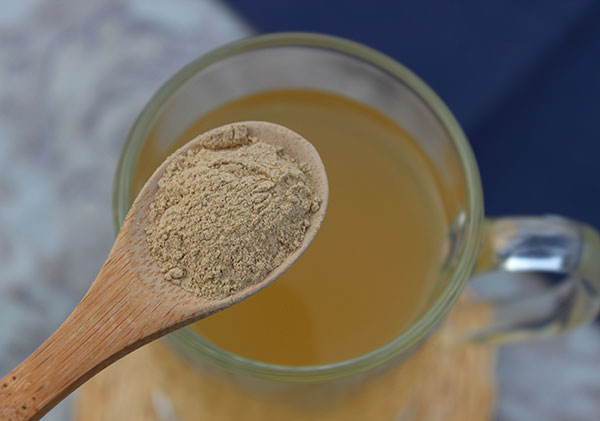
Health Benefits of Ashwagandha
1) Immune Modulating and Stress Reducing Influence
2) Aphrodisiac and Benefits to Reproductive System
3) Ashwagandha's Health Benefits for Women
4) Potential Energy Tonic for Physical Strength
5) Can Promote Restful Sleep
6) May Support the Thyroid Hormone Levels
Immune Modulating and Stress Reducing Influence
Ashwagandha is a powerful immune system modulator that functions specifically as an adaptogen. Adaptogens, a common term used when referring to a number of Chinese major tonic herbs, help to increase our body-mind's ability to "adapt" to daily life stress.
They can act as a buffer protecting the body from the effects of trauma, anxiety and fatigue by normalizing the over-activity or under-activity of the organs and glands.
These qualities are beneficial for long term nerve regeneration and have a positive influence on the adrenals and the entire nervous system.
In Ayurveda it is considered one of the top rasayana tonics, specific for its effects at enhancing physical strength, stamina and "Ojas", or the primal energy, essence similar to "Jing" in Chinese medicine.
In a randomized double-blind study analyzing the effectiveness of ashwagandha root extract on reducing stress and anxiety in adults, it was concluded that it "safely and effectively improves an individual's resistance towards stress and thereby improves self-assessed quality of life."
Rasayana herbs, like ashwagandha, are commonly utilized in the Ayurvedic practice of rejuvenation therapy, or rasayana chikitsa, and are valued as deeply nourishing herbal substances. As mentioned, they are especially appropriate after a cleansing period like pancha karma.
The root, with similar properties to that of rhodiola, is highly prized for its revitalizing effects on nerve and brain function and known to be helpful in the treatment of anxiety induced depression. It is currently being researched as an alternative treatment for those with degenerative diseases such as Parkinson's and Alzheimer's.
According to the journal, Alzheimer's Research and Therapy, "A recent double-blind, randomized, placebo-controlled study on the effects of ashwagandha on stress found that it reduced symptoms of stress and inability to concentrate and reversed forgetfulness in a dose-dependent manner."
Contains Unique Plant Compounds Called Withanolides
Ashwagandha root, as well as the leaves, have been extensively researched for their active triterpenoids and steroidal lactones referred to as withanolides.
Withanolides are a class of naturally occurring phytochemical compounds common to many species in the nightshade family Solanaceae. This includes the golden berry species which also, like the ashwagandha plant, has a similar papery calyx surrounding its fruits.
In current research published in the 2015 Journal of Advanced Pharmaceutical Technology and Research it was identified that approximately 35 withanolides have been isolated from the roots. The major ones being withanoside V, withaferin A, withanolide A and withanolide B.
Withaferin A was the first withanolide isolated from the ashwagandha species and is the one most discussed in scientific literature as it has been shown to possess a number of benefits, including significant antitumor and anti-inflammatory activity.
Withaferin A is one of the main withanolide compounds responsible for the roots effectiveness as an immune system modulator and neurological anti-anxiety agent.
Withanoside IV and V additionally play an important neuroregenerative role and have shown usefulness for spinal cord injury known to "improve hindlimb function and increase the myelin layer in the peripheral nervous system", according to the previous journal mentioned. (*)
In a 2015 published study analyzing withanolide biosynthesis, the leaves were shown to be higher in withanolides suggesting that these properties actually transfer to the root system.
From an herbalist's perspective, most roots of medicinal plants are most potent and ready for harvest after the leaves begin to lose their vitality in the fall season.
Therefore, this withanolide transfer from leaves to roots does make sense as this is generally the time that the weather changes, signaling plants to store up nutrients and energy in their root system to persevere the colder winter months. This is the best time to harvest ashwagandha.
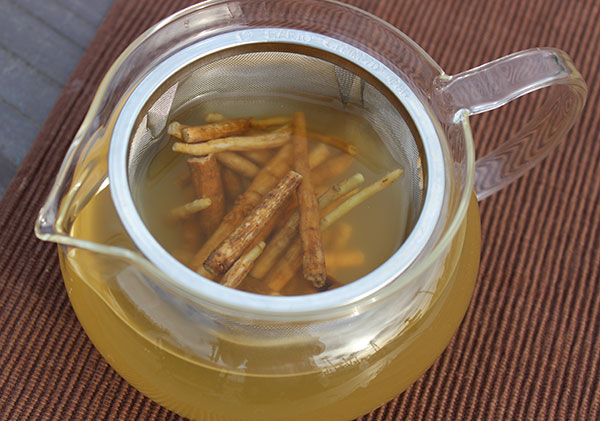
Aphrodisiac Properties and Benefits to the Reproductive System
Although considered an aphrodisiac for both men and women alike, ashwagandha is often viewed as a "male herb" and frequently compared to ginseng for its energy enhancing effects and ability to significantly heighten one's sex drive.
According
to herbalist Dr. Michael Tierra, "In the TCM system ashwagandha would be
used as a Kidney Yang tonic because of its warming, aphrodisiac
properties. One may have to take ashwagandha longer, at least a month,
to notice its aphrodisiac effects."
In Ayurvedic medicine the roots are considered a top tonic herb for male sexual disorders, like low sex drive, impotence and infertility. In the classic Ayurvedic text Charaka Samhita, ashwagandha as well as mucuna pruriens, were identified in the same class of "vajikarana" herbs or reproductive tonics for promoting virility.
It has been identified in published research that the consumption of the root extract was shown to improve semen levels as well as provide an "increase in sperm concentration, ejaculate volume and motile sperm count" in addition to an "increase in the serum levels of testosterone."
In another study it was stated that "Measuring various biochemical and stress parameters before and after treatment, suggested a definite role of stress in male infertility and the ability of W. somnifera to treat stress-related infertility."
The health enhancing benefits of ashwagandha can be augmented with many other libido-supporting superfoods like pine pollen, schizandra, cistanche, tongkat ali, and cordyceps.
Ashwagandha's Health Benefits for Women
Ashwagandha is also utilized as a helpful herb, along with a health
promoting diet, for strengthening the female reproductive system. It is
frequently combined with other Ayurvedic herbs
such as shatavari as well as the Chinese blood tonic, dang quai and it
is particularly useful in treatment of irregular menstruation and
anemia.
Ashwagandha is also known to revitalize libido, improve sexual and reproductive functions for women as well as men.
In one study published in BioMed Research International it was recognized that supplementation with a high-concentration ashwagandha root extract was beneficial for improving sexual function in healthy women. "The results suggest that ashwagandha root extract could be useful for the treatment of FSD [Female Sexual Distress]."
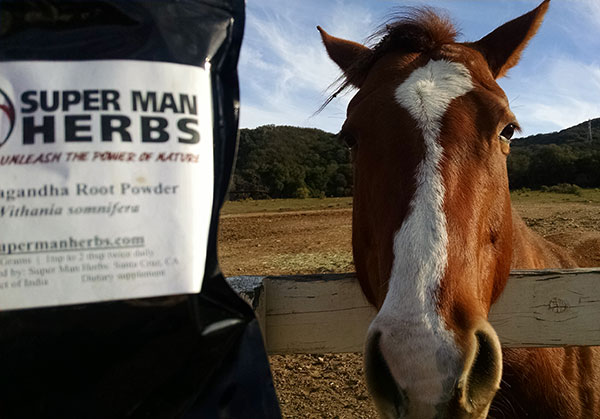 Super Man Herbs is now Lost Empire Herbs
Super Man Herbs is now Lost Empire HerbsPotential Energy Tonic for Increasing Physical Strength
Like ginseng and astragalus, ashwagandha is also classified as a rejuvenative Chi (Qi) tonic because of its claimed actions at increasing physical strength and muscle mass beneficial for a wide range of people including children, seniors as well as body builders. It can be a preferred, as well as less expensive, option to ginseng which can be too over-stimulating for some people.
As mentioned in the book "Rasayana, Ayurvedic Herbs for Rejuvenation and Longevity", the Indian name ashwagandha translates as "ashwa", meaning "horse", and "gandha", meaning "fragrant." This makes reference to the freshly harvested roots, which are believed to have a strong scent with a hay-like aroma.
This is of no surprise as potent aromas are commonly the case with many tonic roots. We, however, find that the dried roots or powders have a fairly mild earthy scent. In Ayurvedic texts, this association is also equated to the strength and sexual stamina of horses or stallions.
In a study analyzing the effects of Withania somnifera
on muscle strength and recovery, it was reported that "ashwagandha
supplementation is associated with significant increases in muscle mass
and strength and suggests that ashwagandha supplementation may be useful
in conjunction with a resistance training program."
While these tonifying effects are somewhat like the stimulating effects of Panax ginseng, ashwagandha is referenced by many herbalists to have calming effect that is soothing to the nervous system.
We actually liken it to be a combination of both American ginseng, which is slightly sedating, and Panax ginseng, which is more of an herbal stimulant. But, again these properties are more or less relevant depending on one's unique constitution and health issues.
Energetically it has a warming nature that is not as hot as Panax ginseng or as cooling as American ginseng.
Traditionally ashwagandha can be combined in restorative energy formulations using tribulus, brahmi as well as the various types of ginseng roots.
Can Promote Restful Sleep
Ashwagandha root is commonly ground into a fine powder and traditionally blended with ghee, honey or milk and consumed before bedtime to promote restful sleep. The Latin word "somnifera" actually means "sleep inducer", which makes reference to its tranquilizing nature.
This aspect of Withania somnifera is especially helpful for Vata body types or women with menopausal sleep disturbance due to changing hormonal influences. We find that it is also helpful to mix the powder with an infusion of other nervines like skullcap and chamomile to increase overall effectiveness.
In addition, women experiencing peri or post-menopausal symptoms also might like to combine ashwagandha with other herbs like shatavari and Am. ginseng, both cooling herbs frequently used in herbal formulations specific for such female life cycles.
May Support Thyroid Hormone Levels
Adaptogens also work to regulate endocrine functions and ashwagandha is particularly known for its ability to help stimulate certain thyroid hormones, like T3 and T4.
While consuming regular dose amounts of the powder, capsules or teas can be useful for those with an under-active thyroid, we always recommend seeking the advice of a qualified medical practitioner before attempting self-treatment.
Earlier studies reveal that ashwagandha root extract can stimulate thyroid hormones and significantly increase thyroxine levels (T4) and in another 2014 published study conducted on patients with biopolar disorder, it was shown that "the thyroid enhancing properties of ASW [ashwagandha] may also represent a clinical opportunity for the treatment of subclinical (mild) hypothyroidism."
It is important to note that supplementing with ashwagandha has also been shown to cause hyperthyroidism in some cases, a condition in which too much thyroid hormone is being produced. It is therefore important to consult your physician if you have either an under-active or over-active thyroid gland before using ashwagandha as a regular dietary supplement.
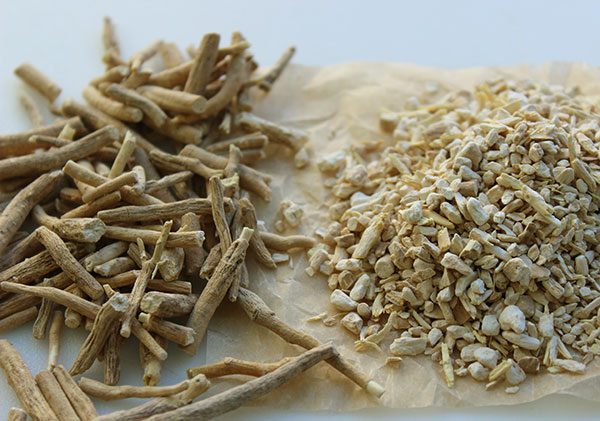
Types of Ashwagandha Root
- Fresh Root - Freshly harvested roots can be used in teas or dried and powdered.
- Dried Root or Pieces - The dried whole roots of fresh ashwagandha are usually cut into shorter whole roots or pieces for use in teas, tinctures or ground into powders.
- Powdered Root - These are whole unprepared roots, sometimes steam sterilized, and ground into a fine powder.
- Capsules or Tablets - Includes either encapsulated powder or compressed powder in tablet form, sometimes contains other ingredients or root extracts.
- Tinctured Extracts - Made by infusing the roots, and sometimes the leaves, in alcohol for at least several weeks.
- Standardized Formulas - Usually standardized to a minimum of 2.5% withanolide content.

How to Use
As we mentioned, herbs from the Ayurvedic pharmacopoeia, like ashwagandha, can be taken alone but are often consumed in blended formulations that consist of about 5-8 different herbal rasayanas and spices in varying proportions.
The roots or powder can be blended with herbs like amalaki, shilajit, shatavari, turmeric, arjuna, ginger, tulsi, bacopa, shankhapushpi, gotu kola, amla and many others.
In ayurvedic medicine it is specific for Vata imbalance and sometimes Kapha, but is considered aggravating to Pitta when used in excess as it is mildly warming to the body.
Most tonics, especially roots, are more beneficial when they are combined as a unit with other herbs, creating a synergistic effect that works to most accurately balance any one particular diagnosis. These preparations can be modified over time by a qualified Ayurvedic specialist to make them more suitable for subtle changing conditions of the patient.
For more on how to create your own unique personalized blends, visit our herbal tea preparation guide.
This is not to say, however, that you can't experiment with different herbs or read more about the unique properties of each in order to personalize your own preparations when appropriate.
Ashwagandha roots are not traditionally decocted (simmered), like Chinese herbs, but almost exclusively used as a dried raw or "steam sterilized" powder mixed into teas, water or customarily combined with ghee, honey or milk.
The powder can also conveniently be added to shake elixirs, kefir and dessert recipes such as oja balls, a spicy energizing tonic herbal snack made with nut butter. The root powder also can be added to dairy or nut milks with other herbs and consumed before sleep to relax and calm the mind.
(Visit our recipe page on how to make ashwagandha milk.)
Building herbs, like ashwagandha, are best taken when one is free of sickness and disease. In addition, tonic herbs should be avoided when undertaking a cleansing or juice fasting protocol.
Suggested Dosage Amount:
It is important to follow the directions of the specific brand you are taking or as directed by your health practitioner. But, generally speaking, the following dosage amounts are good for most people new to the herb. Start out with small doses and build up to larger ones over time.
- Small-Medium dose: ¼-½ teaspoon; once or twice daily
- Higher dose: 1-2 teaspoons; once or twice daily
Precautions:
Large amounts of ashwagandha root should be avoided by those who have an over-active thyroid (hyperthyroid). Excessive doses, especially when new to the herb, may cause intestinal upset. We recommend consulting a qualified health care professional if you are pregnant or breastfeeding, taking prescribed medications or have a serious medical condition.
Shop Related Products (About Affiliates & Amazon Associate Paid Links)
Affiliate Disclaimer: This section contains affiliate product links. If you make a purchase through our recommended links, we receive a small commission at no additional cost to you. Thanks for the support.

